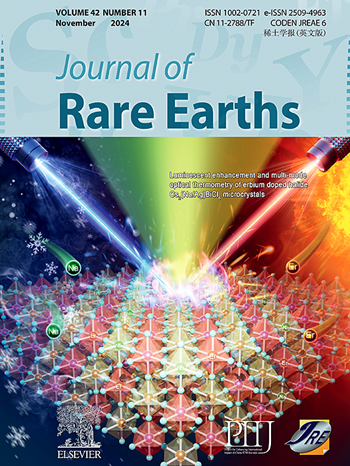Recovery of rare earth elements from sedimentary rare earth ore via sulfuric acid roasting and water leaching
IF 7.2
1区 化学
Q1 CHEMISTRY, APPLIED
引用次数: 0
Abstract
Rare earth elements were extracted using a sulfuric acid roasting-water leaching process. The effect of acid roasting on a new type of low-grade sedimentary rare earth ore found in Guizhou Province, China was analyzed using X-ray diffraction and scanning electron microscopy. A systematic study was conducted on process parameters such as amount of acid, roasting temperature, roasting time, water leaching temperature, and leaching time. The results reveal that the total recovery of rare earth elements reaches 81.37%, which is 3.1 times higher than that achieved through direct acid leaching, under the optimal conditions. In addition, the leaching rate of heavy rare earth elements reaches 72.53%. Rare earth elements and some other valuable metals are transformed into soluble sulfate through the local decomposition of clay minerals under the action of the sulfuric acid attack. The dissolution rates of aluminum, iron, and titanium ions are 34.94%, 17.05%, and 62.77%, respectively. The precipitation rate of Ti reaches 99%, and the loss of rare earth ions in the solution is less than 1%. Meanwhile, the results of a leaching kinetics analysis indicate that the leaching process of rare ions is controlled by diffusion. Precious metal ions such as iron and aluminum in the leaching solution can reduce the adsorption of rare earth ions by kaolinite. This study efficiently recovered rare earth ions under conditions of low calcination temperature and direct water leaching, resulting in reduced energy consumption of the extraction process and acidity of the leaching solution. These findings provide a solid foundation for the further separation and extraction of rare earth ions.

通过硫酸焙烧和水浸法从沉积稀土矿中回收稀土元素
采用硫酸焙烧-水浸法提取稀土元素。利用x射线衍射和扫描电镜分析了酸焙烧对贵州某新型低品位沉积稀土矿的影响。对酸用量、焙烧温度、焙烧时间、水浸温度、浸出时间等工艺参数进行了系统研究。结果表明,在最优条件下,稀土元素的总回收率达到81.37%,是直接酸浸法的3.1倍。重稀土元素浸出率达72.53%。稀土元素和其他一些有价金属在硫酸侵蚀作用下,通过粘土矿物的局部分解转化为可溶性硫酸盐。铝、铁和钛离子的溶出率分别为34.94%、17.05%和62.77%。Ti的析出率达到99%,稀土离子在溶液中的损失小于1%。同时,浸出动力学分析结果表明,稀土离子的浸出过程受扩散控制。浸出液中的铁、铝等贵金属离子可降低高岭石对稀土离子的吸附。本研究在低煅烧温度和直接水浸的条件下,有效地回收了稀土离子,降低了萃取过程的能耗和浸出液的酸度。这些发现为进一步分离提取稀土离子提供了坚实的基础。
本文章由计算机程序翻译,如有差异,请以英文原文为准。
求助全文
约1分钟内获得全文
求助全文
来源期刊

Journal of Rare Earths
化学-应用化学
CiteScore
8.70
自引率
14.30%
发文量
374
审稿时长
1.7 months
期刊介绍:
The Journal of Rare Earths reports studies on the 17 rare earth elements. It is a unique English-language learned journal that publishes works on various aspects of basic theory and applied science in the field of rare earths (RE). The journal accepts original high-quality original research papers and review articles with inventive content, and complete experimental data. It represents high academic standards and new progress in the RE field. Due to the advantage of abundant RE resources of China, the research on RE develops very actively, and papers on the latest progress in this field emerge every year. It is not only an important resource in which technicians publish and obtain their latest research results on RE, but also an important way of reflecting the updated progress in RE research field.
The Journal of Rare Earths covers all research and application of RE rare earths including spectroscopy, luminescence and phosphors, rare earth catalysis, magnetism and magnetic materials, advanced rare earth materials, RE chemistry & hydrometallurgy, RE metallography & pyrometallurgy, RE new materials, RE solid state physics & solid state chemistry, rare earth applications, RE analysis & test, RE geology & ore dressing, etc.
 求助内容:
求助内容: 应助结果提醒方式:
应助结果提醒方式:


